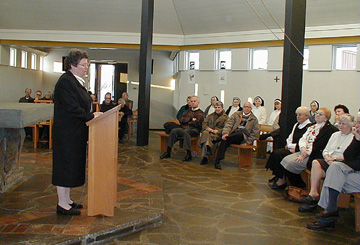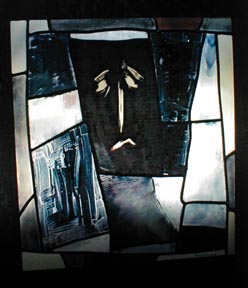 Mount
Saviour Monastery
Mount
Saviour MonasterySr. Mary Collins, osb
On March 11th, the second of the monastery's anniversary lectures was
given by Sr. Mary Collins, OSB, the prioress of St. Scholastica in Atchison,
Kansas. Sr. Mary Collins has written (and taught) extensively on
the liturgy, and she took as her topic the Liturgy of the Hours, which
she called "The Voice of the Praying Church."
In what she called The Big Picture, Sr. Collins described human life
from a cosmic perspective as brief and tragic. We come to consciousness
and responsibility, asking: "If I must someday die, what can I do to satisfy
my desire to live?" For we find ourselves
impelled towards self-transcendence but without knowing what Rahner
calls the "whither." Sr. Collins then discussed what contribution contemplatives
make to this project: "What we Benedictine's are about and why?"
The official claim has always been that the sole contemplative
work is prayer. And for Benedictines especially, that prayer has
been public, choral prayer: the Liturgy of the Hours. But various
historical developments have tended to skew our understanding of this.
One thing, of course, is an emphasis on the individual and subjective experience.
The words and images of choral public prayer may then seem to be an obstacle
to the "real" contemplative work: meditating, centering and the like.
But even that attitude may derive from the distortion of another notion
upon which Sr. Collins concentrated: that contemplatives cannot make a
contribution to society unless they are "doing something." That contemplative
prayer should be a ministry was sometimes turned even by contemplatives
themselves into the idea that they act as "spiritual mercenaries," doing
the praying for busy people who don't have the time! In fact, no
one can do your praying for you; but one has to understand the many forms
of praying.
The public Prayer of the Hours by contemplatives is part
of an articulation of the prayer of the whole Church. In fact, the
Spirit is stirring in the whole of creation, and not just in the fields
of flowers but in the fields of trash "which are waiting for redemption."
People are sometimes put off by the anguish and bitterness expressed in
the psalms. But using a number of concrete and moving examples, Sr. Collins
showed how the range of emotions in the Psalms "collect" the range of emotions
to be found in people everywhere in their day-to-day existence. And
in this way, they give "Voice to the Prayer of the Church."
The Liturgy of the Hours, Sr. Collins claimed, is a priestly ministry,
not in the sense of someone specially consecrated to administer the sacraments
but in a very old and traditional sense of intermediaries "between porch
and altar." Christians, both lay and ordained, are "priestly advocates";
and praying communities embody (or "incarnate") the longing of all - including
the longing expressed in their own ways by the youth of today.
Sr. Collins listed some advantages of the Liturgy of the
Hours for speaking to people in our day. It does not exclude anyone,
as our Liturgy of the Eucharist does. And it draws no distinction
between clergy and laity, expressing the common struggle of all the baptized
to work out their Christian identity. And for the monks especially,
the Hours are a community-forming practice, involving the discipline of
"mercy overcoming anger."
Sr. Collins characterized the stability of Benedictine
life as "a witness to God's faithfulness," and the monastic presence and
hospitality as "honoring place, tradition and commitments."
The talk was followed by a lively question and answer
period and a reception.
News:
Many monks went away during the month for family events or special
ministry: Fr. Martin, Br. Stephen, Br. Alexis, Br. Pierre and Br. James
Kelly. Many feasts occur, this month, including the solemnity
of St. Benedict. On the 4th Sunday of Lent, we sang Vespers and Compline
at Grace Episcopal Church. It is an enjoyable ecumenical gathering.
For the week-end of the 16th, the Company at Kirkridge was here
to reflect on the Contemporary Meaning of Lent. One of the
features was the Way of the Cross with transparencies of the Stations of
the Cross created by Frederick Franck. They
were displayed on the windows of the chapel during Lent.
Veronica wiping the face of Jesus.
Jesus on the Cross


Holy Week Schedule:
Holy Thursday: Mass of the Lord's Supper at 5:00 p.m.
Good Friday: Celebration of the Lord's Passion at 3:00 p.m.
Easter Sunday: Paschal Vigil & Mass at 4:15 a.m.
Coming Events:
Sunday, May 6th at 3pm, the Genesee Valley Orchestra and Chorus.
They will perform at the Clemens Center in Elmira. Ticket prices
range from $5-$15. This award-winning group of 40 musicians and 90
voices was established by Sr. Virginia Hogan of Rochester and has performed
both in this country and in Europe. The choral group will sing at
a 10am Mass at the monastery and the monks will begin the program at the
Clemens Center by chanting None.
Previous month
Mount Saviour page
Guest Brother E-mail: guest@msaviour.org
Monastery E-mail: info@msaviour.org